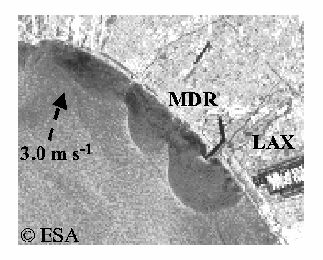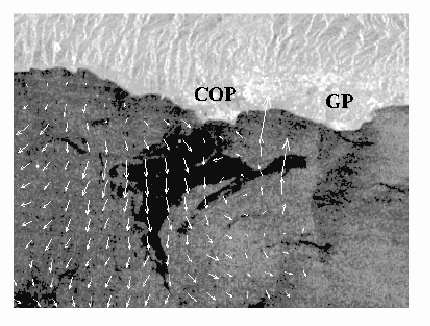
Pollution Hazards off the Southern California Coast: Satellite and In-Situ Observations of
Naturally Occurring Oil Seepage and Storm Water Runoff Plumes
Abstract:
The coastal waters off southern California are characterized by anthropogenic and nat-
urally- occurring pollution hazards. Pollutant-laden storm water runoff plumes are common
coastal ocean features throughout the Southern California Bight following winter storms. In
Santa Monica Bay, these plumes have been associated with high toxicity and water-borne patho-
gens. Natural liquid oil seepage is observed throughout the year in the Santa Barbara Channel off
Coal Oil Point, and in Santa Monica Bay off Redondo Beach. The size and episodic nature of
these phenomena, however, make them difficult to characterize by conventional shipboard sam-
pling. Space-borne synthetic aperture radar (SAR) sensors are well suited to observing them
since they provide frequent, synoptic, high-resolution, all-weather observations. The aim of this
project is to initially quantify the frequency of occurrence, spatial extent, and dynamics of natural
oil slicks and storm water runoff plumes off the coast of southern California using multi-sensor
SAR data (e.g., Radarsat, ERS-1, ERS-2). Surfactants from these pollution hazards smooth sur-
face waters, making them readily observable by SAR. These SAR observations will be comple-
mented by other satellite (e.g., ocean color, AVHRR) and coincident field data (e.g., surface
currents from HF coastal radar arrays and buoys, winds, precipitation, discharge) where possible.
In particular, we hope to characterize the time-space response of these phenomena to variable
oceanographic and atmospheric conditions. In this regard, the observation of natural oil slicks
could provide important insights into the movement of accidental oil spills, including likely dis-
persal patterns. We expect this research will contribute to an improved understanding of pollution
hazards in southern California coastal waters, and provide valuable information for coastal man-
agement.

Caption:
Pollutant-laden storm water runoff plumes are common coastal ocean features throughout the
Southern California Bight following winter storms. In Santa Monica Bay, these plumes have been
associated with high toxicity and water-borne pathogens. This ERS-1 synthetic aperture radar
(SAR) image illustrates the spatial extent of one of these plumes in the bay. Wind direction and
speed are indicated by the black arrow, `MDR' denotes Marina del Rey, and `LAX' denotes the
airport.

Caption:
Natural liquid oil seepage is observed throughout the year in the Santa
Barbara Channel and in Santa Monica Bay.
This Radarsat SAR image illustrates seepage off Coal Oil
Point (COP) and Goleta Point (GP) in the Santa Barbara
Channel. Surface current vectors from shore based
HF radar arrays are overlaid in white, corroborating the apparent
offshore flow field indicated by the SAR image.
Reference:
DiGiacomo, Paul M. Benjamin Holt, and Libe Washburn,
Pollution Hazards off the Southern California Coast: Satellite and In-Situ Observations of
Naturally Occurring Oil Seepage and Storm Water Runoff Plumes, AGU Ocean Sciences Meeting, Honolulu, Hawaii, February 2002.

|

